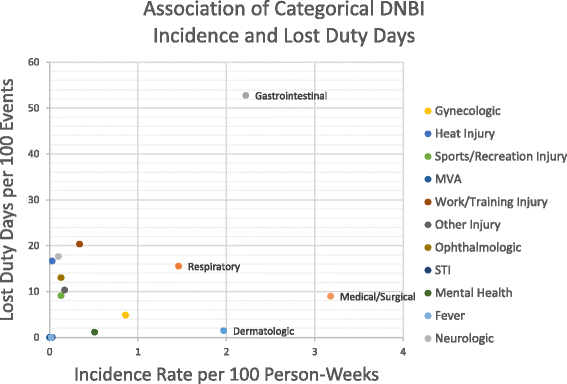Incidence and risk factors for disease and non-battle injury aboard the hospital ship USNS COMFORT during a Humanitarian Assistance and Disaster Response Mission, Continuing Promise 2011
- PMID: 28883951
- PMCID: PMC5530908
- DOI: 10.1186/s40794-016-0023-z
Incidence and risk factors for disease and non-battle injury aboard the hospital ship USNS COMFORT during a Humanitarian Assistance and Disaster Response Mission, Continuing Promise 2011
Abstract
Background: Disease and non-battle injury (DNBI) are a leading cause of morbidity in deployments and can compromise operational mission performance. No study to date has examined DNBI incidence and impact aboard humanitarian aid/disaster response (HADR) mission ships.
Methods: From April to September 2011, US military and civilian personnel participated in Continuing Promise 2011, a HADR training mission aboard USNS COMFORT (T-AH 20). Health surveillance was conducted for the purpose of assessing DNBI trends and improving force health protection during the deployment through passive surveillance, collection of DNBI data among those seeking care at the ship's clinic, and actively through use of an anonymous weekly, self-report questionnaire. Categorical and total DNBI incidence rates were calculated per 100 person-weeks and incidence rate ratios (IRR) were calculated utilizing a negative binomial model to assess potential risk factors.
Results: The leading syndrome-specific cause of weekly visits to the ship's clinic was gastrointestinal (GI) followed by dermatologic and respiratory conditions (2.22, 1.97, and 1.46 cases per 100 person-weeks, respectively). The top three categorical DNBI were similarly represented by the questionnaire, with respiratory conditions having the highest reported rate followed by dermatologic and GI (11.79, 8.71, and 7.38 cases per 100 person-weeks, respectively). GI had the highest morbidity measures accounting for 61.9 % of lost work days and 27.3 % of reported moderate/severe impact to mission performance. Several factors were also associated with increased DNBI rates including personnel ages 26-36 (IRR = 1.23), officers (IRR = 1.23), days-off-ship (IRR = 1.09), and affiliation with nursing services (IRR = 1.48), naval mobile construction battalion (IRR = 3.17), and security (IRR = 1.71).
Conclusions: DNBI can significantly impact mission performance on HADR missions, and establishing baseline rates and identifying risk factors can help improve force health protection in future HADR missions.
Keywords: DNBI; Disaster response; Disease and non-battle injury; Epidemiology; Humanitarian assistance; Military; Occupational medicine.
Figures
Similar articles
-
The Epidemiology of Operation Stress during Continuing Promise 2011: A Humanitarian Response and Disaster Relief Mission aboard a US Navy Hospital Ship.Prehosp Disaster Med. 2017 Aug;32(4):393-402. doi: 10.1017/S1049023X17000218. Epub 2017 Mar 20. Prehosp Disaster Med. 2017. PMID: 28318462
-
Incidence, Etiology and Risk Factors for Travelers' Diarrhea during a Hospital Ship-Based Military Humanitarian Mission: Continuing Promise 2011.PLoS One. 2016 May 12;11(5):e0154830. doi: 10.1371/journal.pone.0154830. eCollection 2016. PLoS One. 2016. PMID: 27171433 Free PMC article.
-
The Surgical Experience Aboard USNS COMFORT (T-AH-20) during Operation Continuing Promise 2015.Am Surg. 2018 Aug 1;84(8):1307-1311. Am Surg. 2018. PMID: 30185306
-
Disease and Non-Battle Injury in Deployed Military: A Systematic Review and Meta-analysis.Mil Med. 2024 Aug 19;189(Suppl 3):21-30. doi: 10.1093/milmed/usae033. Mil Med. 2024. PMID: 39160823
-
US Navy Ship-Based Disaster Response: Lessons Learned.Curr Trauma Rep. 2022;8(3):138-146. doi: 10.1007/s40719-022-00227-3. Epub 2022 May 3. Curr Trauma Rep. 2022. PMID: 35529774 Free PMC article. Review.
Cited by
-
Training Military Psychiatrists to Adapt and Overcome: How COVID-19 Highlighted the Unique Flexibility of Military Psychiatry in Training and in the Fleet.Curr Psychiatry Rep. 2022 Aug;24(8):369-374. doi: 10.1007/s11920-022-01342-3. Epub 2022 Jun 14. Curr Psychiatry Rep. 2022. PMID: 35699916 Free PMC article. Review.
-
Travelers' diarrhea: update on the incidence, etiology and risk in military and similar populations - 1990-2005 versus 2005-2015, does a decade make a difference?Trop Dis Travel Med Vaccines. 2019 Jan 15;5:1. doi: 10.1186/s40794-018-0077-1. eCollection 2019. Trop Dis Travel Med Vaccines. 2019. PMID: 30675367 Free PMC article.
-
Management of Acute Diarrheal Illness During Deployment: A Deployment Health Guideline and Expert Panel Report.Mil Med. 2017 Sep;182(S2):34-52. doi: 10.7205/MILMED-D-17-00077. Mil Med. 2017. PMID: 28885922 Free PMC article.
References
-
- Champion HR, Bellamy RF, Roberts CP, Leppaniemi A. A profile of combat injury. J Trauma. 2003;54:S13–9. - PubMed
-
- Blood CG. Outpatient illness incidence aboard U.S. Navy ships during and after the Vietnam conflict. Mil Med. 1990;155:472–6. - PubMed
-
- Blood CG, Pugh WM, Gauker ED, Pearsall DM. Comparisons of wartime and peacetime disease and non-battle injury rates aboard ships of the British Royal Navy. Mil Med. 1992;157:641–4. - PubMed
-
- Deputy Secretary of Defense . Joint medical surveillance. Washington: Department of Defense; 1997.
LinkOut - more resources
Full Text Sources
Other Literature Sources
Miscellaneous


